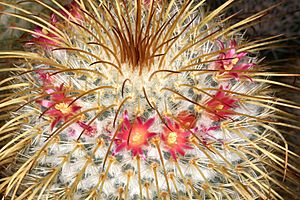Mammillaria dixanthocentron facts for kids
Quick facts for kids Mammillaria dixanthocentron |
|
|---|---|
 |
|
| Scientific classification | |
| Genus: |
Mammillaria
|
| Species: |
dixanthocentron
|
Mammillaria dixanthocentron is a fascinating type of cactus that belongs to a large group of cacti called Cactoideae. This special plant was first described in 1963 by a botanist named Curt Backeberg. Like many cacti, Mammillaria dixanthocentron is known for its unique look and ability to survive in tough, dry places. It's a popular choice for cactus lovers because of its interesting spines and pretty flowers.
Contents
What is Mammillaria dixanthocentron?
Mammillaria dixanthocentron is a small, round cactus that grows slowly. It's part of the Mammillaria genus, which is one of the largest groups of cacti, with over 200 different kinds. These cacti are often called "pincushion cacti" because of their shape and how their spines stick out like pins from a pincushion.
Where Does This Cactus Live?
This particular cactus comes from dry, rocky areas, mostly in parts of Mexico. It's used to living in places where there isn't much rain and the sun is very strong. Its natural home is often on hillsides or in deserts, where it can find small cracks in rocks to grow in. The cactus has special ways to store water, which helps it survive long periods without rain.
What Does It Look Like?
Mammillaria dixanthocentron usually grows as a single, ball-shaped stem, but sometimes it can form small clumps of several stems. The stem is typically a bright green color. Instead of ribs like some other cacti, it has many small, cone-shaped bumps called tubercles. These tubercles are arranged in spirals around the cactus.
Spines and Flowers
Each tubercle on Mammillaria dixanthocentron has a small, woolly spot at its tip where the spines grow. This cactus is famous for its beautiful spines, which are often yellow or golden-brown, making it look very striking. It usually has several short, stiff spines that point outwards, and sometimes a longer, stronger spine in the center.
When it's time to bloom, this cactus produces small, funnel-shaped flowers. These flowers often appear in a ring around the top of the plant. They can be different colors, like pink, red, or white, and they add a lovely splash of color to the cactus. After the flowers fade, small, red or pink fruits might appear, which contain the seeds.
How Does It Grow?
Growing Mammillaria dixanthocentron is quite easy if you know what it needs. Like most cacti, it loves lots of sunlight. It needs well-draining soil, which means soil that doesn't hold too much water, because too much water can make the roots rot. During the warmer months, it needs regular watering, but it's important to let the soil dry out completely between waterings.
In the winter, when it's colder, the cactus needs very little water, or sometimes none at all. This is its resting period. It's also important to protect it from very cold temperatures, as it's used to warm climates.
Life Cycle and Reproduction
The life cycle of Mammillaria dixanthocentron begins with a tiny seed. If the seed lands in a good spot with enough warmth and a little moisture, it will sprout into a small seedling. This seedling will slowly grow into a mature cactus over several years.
Once the cactus is old enough, it will start to produce flowers, usually in the spring or summer. These flowers are pollinated by insects, like bees, which carry pollen from one flower to another. After successful pollination, the flowers develop into small fruits. Inside these fruits are the new seeds. When the fruits ripen, they can be eaten by animals or simply fall to the ground, scattering the seeds and starting the cycle all over again. Sometimes, new small cacti, called "offsets," can grow from the base of the main plant, which is another way this cactus can reproduce.
See also
 In Spanish: Mammillaria dixanthocentron para niños
In Spanish: Mammillaria dixanthocentron para niños

